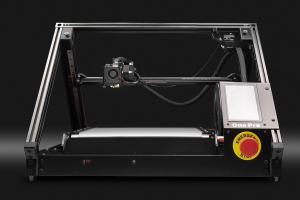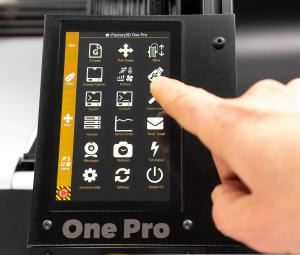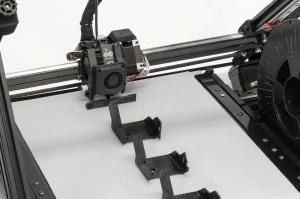How a unique 3D printer with conveyor belt will transform volume production
Automated additive manufacturing at a low entry price is here now with the One Pro 3D belt printer. Learn about your options with its unique AM machine features
DüSSELDORF, NORDRHEIN-WESTFALEN, DEUTSCHLAND, March 24, 2023/EINPresswire.com/ -- 3D printers have become an almost indispensable tool in industry and commerce for the production of prototypes, models, and personalized custom products. And the continuous adaptation to a wide range of materials that can be processed allows for increasingly complex and sophisticated exhibits. With one caveat: The devices have only ever been able to produce objects no larger than themselves. Therefore, the usual desktop-format 3D printer models very quickly reached their limits and, without manual post-processing, quickly became uninteresting for industrial scale. There was, therefore, no talk of "endless" workpieces and automated mass production in the context of additive manufacturing. A 3D printer with a conveyor belt is now changing that.In the mid-2000s, the concept of 3D printers slowly became better known, and by the early 2010s at the latest, the new technology was on everyone's lips. The small devices were mainly used for home use and impressed with the almost limitless design possibilities: With the help of the layering process, the most diverse objects can be realized. For hobby users and producers of personalized products or extravagant items in small runs, this is a rewarding field of activity.
The advantages of additive manufacturing did not remain closed to industry, so the machines also found their way into more technical applications. On a larger scale, commercially and industrially, 3D printer usage has focused primarily on prototyping, scale models, and complex workpieces. However, as the range of printable materials and material combinations continues to expand - in addition to plastic and metal, these can include resin, sand, glass, concrete, or ceramics - 3D printing is becoming increasingly attractive for the manufacture of end products. Reports of milestones such as entire houses, bridges, or boats made by 3D printers are making their way through the media. However, the fact that media attention is still very high in these cases also shows that it is not yet common to use 3D printing for such large-scale projects. 3D-printed objects for end users still account for only a fraction of the market share. As R&D progresses, though, building one's business model on 3D printing technology is becoming increasingly attractive.
But to effectively use 3D printing for its business, some difficulties arise with commercially available devices. One of them is printing between two points not connected by a joint base, such as bridges, overhangs, or hollow bodies. Here, the usual method quickly results in sagging of the printed material due to simple laws of physics. In these cases, additional structures are added to support the main design. However, this also means that printing takes longer, more material is required, and thus a considerable additional economic expense is incurred.
The second difficulty is printing "continuous objects," i.e., several meters long items. Conventional 3D printers reach their limits here due to their design with a rigid printing base. Large-format printers can fulfill such dimensions to a certain extent but often cost a six-figure sum or higher and are thus not available to small companies. In addition, they also require the appropriate floor space, which is not readily available to every medium-sized company either. And last but not least, 3D printers in any form lack true automation. Regardless of the size of the printer, it always relies on being manually emptied after a print job in order to start a new job. If the print area is full, production cannot continue until an employee has taken care of the device. The devices are, therefore, currently unsuitable for series production on a larger scale.
Eliminating these shortcomings of additive manufacturing is the goal of iFactory3D GmbH from Düsseldorf. Founded in 2020 by Artur Steffen and Martin Huber, the startup has developed the "One Pro," a conveyor belt 3D printer that can theoretically print infinitely long objects - with a footprint that fits on any desk. With a continuous conveyor belt instead of a rigid print base, the printer handles the automatic production of larger batches largely automatically, thanks to a print queue and material sensor. With a sufficient supply of filament, the device can print for days or weeks, even months. And thanks to a 45-degree angle setting of the print head, even complex shapes such as cavities are no problem without additional support structures. All in all, iFactory3D speaks of drastic time and material savings as well as a reduction in production costs of up to 40 percent on average for small and medium series. As a result, the One Pro has the potential to make 3D printing a fast and cost-effective alternative to conventional manufacturing processes.
The One Pro handles a wide range of filaments, including PETG, PLA, ABS, ASA, TPU, PC, and nylon. Parts installed in the printer, such as guide rails, extruders, nozzles, and conveyors, are sourced from European suppliers, meet high-quality standards, and are often considered by experts to be among the leading products in their price range.
For customers who are just learning the technology, iFactory3D offers professional training. Companies can book exclusive online training courses for their employees, in which extensive know-how on 3D (belt) printing is imparted. In addition, the experts are available with personal support for all questions. E-mails are handled in German and English, and telephone and video calls can also be arranged for more complex problems. The in-house research and development department also provides support in developing new and optimizing existing 3D projects and consults on material selection and equipment.
Anyone wishing to outsource the printing of test products or series completely can draw on a great deal of expertise at iFactory3D. With their in-house print farm, the Düsseldorf experts produce high-quality prototypes, large workpieces, and series in any quantity at a fair price.
However, the most attractive unit costs can be achieved by purchasing a One Pro of one's own.
Companies that want to produce particularly long and complex workpieces quickly and cost-effectively or plan to go into series production will find their solution in the One Pro, an advanced 3D printer with conveyor belt.
Corinna Marmetschke
iFactory3D GmbH
+49 21115856575
email us here
Visit us on social media:
LinkedIn
YouTube
Instagram
TikTok
Facebook
Twitter
Legal Disclaimer:
EIN Presswire provides this news content "as is" without warranty of any kind. We do not accept any responsibility or liability for the accuracy, content, images, videos, licenses, completeness, legality, or reliability of the information contained in this article. If you have any complaints or copyright issues related to this article, kindly contact the author above.



